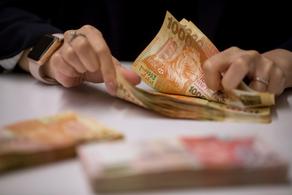 An employee counts Hong Kong one-thousand dollar banknotes at the Hang Seng Bank Ltd headquarters in Hong Kong, April 16, 2019. (PHOTO / BLOOMBERG)
An employee counts Hong Kong one-thousand dollar banknotes at the Hang Seng Bank Ltd headquarters in Hong Kong, April 16, 2019. (PHOTO / BLOOMBERG)
The Hong Kong Monetary Authority (HKMA) intervened for the third time in a day to defend its currency peg as the local dollar touched the strong end of its trading band.
Gains in the local currency have been “mainly driven by increases in market carry-trade activities and equity-related demand,” said HKMA Chief Executive Eddie Yue
The HKMA sold HK$1.55 billion (US$200.01 million) of the city’s currency Wednesday afternoon, after sales of HK$2.79 billion in the early hours of Wednesday local time. It sold another HK$1.55 billion late Tuesday. The aggregate balance, a measure of interbank liquidity, will increase to HK$64.97 billion on April 24, 2020, a HKMA spokesman said.
Higher local interest rates relative to the greenback have made buying the Hong Kong dollar an appealing trade in recent weeks, despite the dire economic pressures facing the face. It’s the first time since October 2015 that the HKMA has defended the peg at the strong end.
Gains in the local currency have been “mainly driven by increases in market carry-trade activities and equity-related demand,” said HKMA Chief Executive Eddie Yue in a statement Tuesday, adding that higher fiscal spending will also boost demand for Hong Kong dollars.
ALSO READ: HK dollar gains against the greenback driven by active carry trade

The local currency has jumped 0.5 percent this year, the best gain among 31 major global exchange rates after the yen.
Continued sales by the authority would ease liquidity, which may reduce interest rates in the city. The one-month interbank borrowing costs in the currency, known as Hibor, rose to 1.55 percent on Wednesday, compared with 0.67 percent for Libor as of last week.
“The interest-rate gap between the Hong Kong dollar and the greenback will support the city’s currency in the near term,” said Ken Cheung, chief Asia foreign-exchange strategist at Mizuho Bank Ltd. “The intervention will continue, but it will be gradual.”
READ MORE: Hong Kong sells US$200 million of local currency to defend peg

Hong Kong’s economy could do with all the help it can get. Business are reeling from the double blow of anti-government protests last year and the ongoing coronavirus pandemic. The jobless rate has climbed to the highest level since 2010 while retail sales plummeted 44 percent in February. The government recently announced a HK$140 billion spending package to stimulate growth.
Fitch Ratings on Monday downgraded Hong Kong’s long-term, foreign currency debt to AA- from AA, predicting real gross domestic product to fall 5 percent this year after a 1.2 percent decline in 2019.
READ MORE: Govt rejects Fitch downgrade, says HK's core competitiveness intact
Liquidity in the special administrative region was tightened by a series of currency interventions in the past two years when lower borrowing costs relative to the US helped drive the currency to the weak end of its trading band. That helped shrink the aggregate balance by 70 percent to HK$54 billion before the current Hong Kong dollar sales.
The currency will likely stay close to HK$7.75 throughout the second quarter, said Stephen Chiu, a foreign-exchange and rates strategist at Bloomberg Intelligence. This means the HKMA may boost the aggregate balance by more than HK$100 billion through retiring some outstanding exchange-fund bills and notes and intervening at the strong end, he added.


